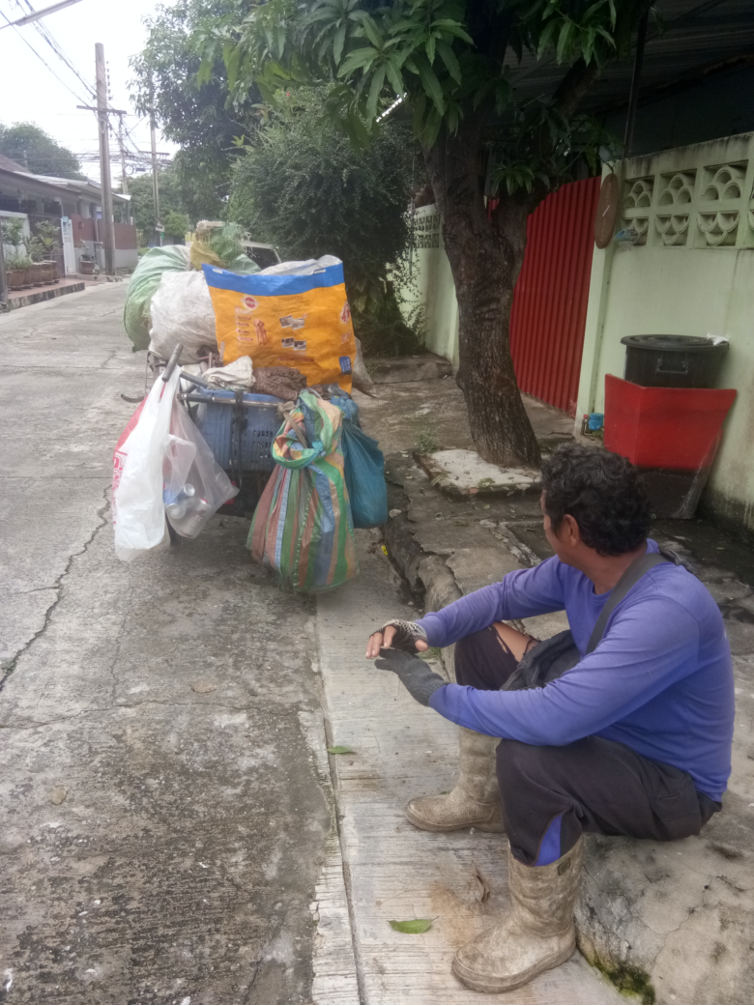As opposed to a sit-down environment used in traditional interviewing, the walk along led to recollection of memories, experiences, associations, and rich qualitative data based on spatial prompts, write Charrlotte Adelina, Diane Archer, and Nattakorn Noyvanich
_______________________________________________
“Walk along” is a mobile research methodology used in social sciences. Also known as “go along” or “walking interview”, the method involves collecting data while walking with respondents, using a mix of interview and participant observations. The interview can be designed in an unstructured or semi-structured format (Carpiano, 2009). Although the walking route can be undetermined or decided by the researcher as part of the design (Evans & Jones, 2011), we used the “natural walk-along” (Kusenbach, 2003) technique, in which waste-pickers talked to the interviewer while going about their usual walking (and working) route:
“Noi continued to collect waste by removing the waste packed in the black bags and laying them on the floor. Then she used her hands to rummage the waste put on the floor with no fear that something would hurt her hands. Most of the waste that Noi got were plastic bottles and small boxes. But despite the hot weather, Noi continued to tirelessly collect waste. At the same time, the data collector stood and observed Noi’s waste collection with an umbrella.” – Fieldwork notes
Our aim was to unpack the contributions of informal waste workers [called salengs in Thai] in contributing to a circular economy and understanding the societal, technical, and policy barriers for informal waste pickers who carry out a major role in plastics recycling. As part of this project, we collected survey data with thirty-four waste-pickers in Bangkok and supplemented this information with a detailed walk-along with ten of them. Our research assistant, Nattakorn, walked with the waste-pickers for a duration of about an hour, without asking any pointed interview questions, but walking along and gathering general reflections on the topic of interest.
The method was found to be suitable for a number of reasons. Primarily, while interviewing subjects with mobile occupations, a sit-down interview takes working time away from participants. It is crucial that researchers reduce the cost paid by participants for research participation by design. As street waste workers rummage around streets, public trash bins, and public spaces to find trash, we felt that the walk-along method was less impedimental to their work, as we interviewed them during their work hours.
Second, the power relationship between the researcher and the participant can be stricter in a formal setting, as opposed to a situation where the researcher enters a milieu familiar to the subject. While working with precarious workers such as the saleng, researcher can adopt more flexible approaches to research that suits the need of the respondents and explore less “safe” spaces. Even though Nattakorn was initially worried about entering environments like a garbage dump with dirt and rats and cockroaches, later on he felt that this was a part of his country which continues to exist and was not so terrible after all. While it is often difficult to gain trust in more formal environments, the walk-along provides a greater space for establishing rapport and trust between the researcher and the respondent (Jones et al., 2008). In this vein, our field work too had snippets of casual exchanges outside the scope of the research between the interviewer and interviewee:
“The data collector began to help Boon to find the trash, telling her where there were bottles to collect”.
“He reminded the data collector to be careful of the car, as the data collector used a mobile phone to jot notes along the way.”
Figure 1: A saleng taking a break at work. Photo by research assistant, Ms. Pipat Napaporn, during a walk along exercise in Bangkok.
Thirdly, the kind of data collected relies on the environment and space in which the interaction takes place (Evans & Jones, 2011; Jones, Bunce, Evans, Gibbs, & Hein, 2008). As opposed to a sit-down environment used in traditional interviewing, the walk along led to recollection of memories, experiences, associations, and rich qualitative data based on spatial prompts. For instance, field notes from the walk-along often illustrated where waste-pickers pointed to accessible and inaccessible spaces, based on the place through which they were walking past:
“We [salengs] are not allowed to collect waste in this community [here], but I can collect waste from the trash bins”
“Walking past another house with a washing machine placed in front of the house, she said that this house usually collects the bottles for her. The house owner will put the bottles in the washing machine. When the machine is fully filled with the bottles, the house owner will give the bottle to her”.
Even if the waste-pickers did not share such information, the activity gives a space to discern a “lot of their issues from observation without asking about it”, reflects Nattakorn. For instance, a waste-picker did not collect wastes in front of occupied houses and moved along quickly in streets with traffic, so as to not get chased away by people or the traffic police.
Fourth, the time invested, and trust developed with waste-workers, gave the project a very in-depth understanding of the lived experiences of waste workers. It became easier for the researcher to interpret the lived environment and the relationship of the participants with people and space (Clark & Emmel, 2010; Kusenbach, 2003). Informants showed greater comfort and provided more information in the walk-along activities than while asked about their challenges through open-ended survey questions. People often narrated deeply personal instances and conditions of chronic poverty and precarity:
[Pointing to his house next to the dumpsite] “Panit also told of how difficult it is to raise a child. Sometimes he has no money to buy milk for the child. The child had to drink plain water or condensed milk. He dissolves condensed milk in water first, and then feeds his child with it.”
“She told the data collector that today she is determined to collect waste because she had no money to spend due to a long time off. She has to pay for water and electricity bills”
Finally, the process can aid a change of perceptions and personal reflections due to the immersive experience provided. In our case, this led to reflections on the class inequalities between the researchers and the interviewees and a questioning of what is usually perceived as “unsafe”, “dirty” or “worthless” in the city. Nattakorn shares: “after you get a walk along, the data collector will feel that the garbage is valuable and costly, for example, when you see a plastic bottle falling, you will think that if you sell it, you will get money.” He also adds that it is a more enjoyable way of data collection, as he could also help collect garbage and walk while collecting data.
However, as with designing any research, care needs to be taken that the method follows ethical deliberation and review. Critical reflection on part of researchers, who have an option to ‘enter’ and ‘exit’ the research environment is needed. In our case, we use the method after ensuring that (1) the method was ethically and contextually appropriate, (2) the participants were compensated in kind (protection equipment) for the time spent in the study, (3) both the interviewer and interviewee were safe during the time of data collection and provided informed consent and (4) the anonymised information collected will not be disseminated in a way that causes harm to participants. Although some researchers map the routes walked (Evans & Jones, 2011), this needs to be decided on a project-basis to ensure the participants are not at a risk of harm as a result of disclosing location-specific or other sensitive data.
With the help of our findings, we aim to secure more recognition of waste-pickers in the society and raise awareness of the general population and policymakers. In summary, combining spatial approaches with qualitative data collection like the walk-along technique were useful in identifying everyday barriers that waste-pickers face while contributing to plastic recycling in Bangkok city.
Acknowledgements
All names of waste-pickers have been changed to protect the identity of participants. This research was funded by the Swedish Research Council for Sustainable Development (FORMAS).
References
Carpiano, R. M. (2009). Come take a walk with me: The “Go-Along” interview as a novel method for studying the implications of place for health and well-being. Health and Place, 15(1), 263–272. https://doi.org/10.1016/j.healthplace.2008.05.003
Clark, A., & Emmel, N. (2010). Using walking interviews. ESRC National Centre for Research Methods, 1–6. Retrieved from http://www.manchester.ac.uk/realities/resources/toolkits
Evans, J., & Jones, P. (2011). The walking interview: Methodology, mobility and place. Applied Geography, 31(2), 849–858. https://doi.org/10.1016/j.apgeog.2010.09.005
Jones, P., Bunce, G., Evans, J., Gibbs, H., & Hein, J. R. (2008). Exploring space and place with walking interviews. Journal of Research Practice, 4(2), 1–9.
Kusenbach, M. (2003). Street Phenomenology. Ethnography, 4(3), 455–485. https://doi.org/10.1177/146613810343007
_______________________________________________
About the research
Our research in Bangkok aims to unpack the role of informal waste workers in contributing to plastics recycling. In this blog, we reflect on the uses of the ‘walk along’ technique, where the researcher walked along the working routes of the waste-picker. Spatial approaches were useful in understanding the everyday barriers faced by waste-pickers in plastics recycling. The technique also helped establishing rapport and lessened the power differences between the researcher and the respondent.
For citation: Adelina, C., Archer, D., & Noyvanich, N. (2021) Walking with Bangkok’s waste pickers. Field Research Methods Lab at LSE (4 May) Blog entry. URL: https://blogs.lse.ac.uk/fieldresearch/2021/05/04/walking-with-bangkoks-waste-pickers/







1 Comments